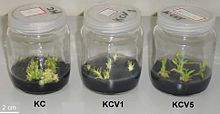– **Production of Vinasse:**
– Byproduct of sugar or ethanol industry
– Result of processing sugarcane or sugar beet
– After removal of desired products, remaining material is vinasse
– Commercially offered as cane-vinasse or beet-vinasse
– High fulvic acid concentration due to distillation process
– **Uses of Vinasse:**
– Source of biogas in thermophilic digesters
– Can be used as fertilizer
– Source of methane for heat or electricity generation
– Formulation of nutritive solutions for hydroponics
– Formulation of culture media for plant tissue culture
– **Applications of Vinasse:**
– Used in culture media for orchid elongation and rooting
– Formulated as a 2.5% dilution for plant growth
– Suitable for media free of plant growth regulators
– Utilized in algal growth culture media
– Research on vinasse culture medium for plant tissue culture
– **Related Topics:**
– Bagasse
– Dunder
– **References and Further Reading:**
– Hidalgo, K. (2009) – Vinasse in feed: Good for animal and environment
– Santos, J. D. et al (2013) – Development of vinasse nutritive solutions for hydroponics
– Silva, A. L. L. et al (2014) – Development of vinasse culture medium for plant tissue culture
– Gollo, A. L. et al (2016) – Plant culture medium composed of vinasse from Haematococcus pluvialis
– Tejada, M., Gonzalez, J.L. (2006) – Effects of beet vinasse on soil physical properties and soil loss
Vinasse is a byproduct of the sugar or ethanol industry. Sugarcane or sugar beet is processed to produce crystalline sugar, pulp and molasses. The latter are further processed by fermentation to ethanol, ascorbic acid or other products. Juice sugarcane can also be processed directly by ethanol fermentation. After the removal of the desired product (alcohol, ascorbic acid, etc.) the remaining material is called vinasse. Vinasse is sold after a partial dehydration and usually has a viscosity comparable to molasses. Commercially offered vinasse comes either from sugar cane and is called cane-vinasse or from sugar beet and is called beet-vinasse. Vinasse produced from sugar cane is also called dunder.
In the process of distillation of the alcohol and as a result of the heating in the distillation process, in the pulp of the beet reactions of condensation and predominantly molecular ruptures take place. This causes a high fulvic acid concentration in this byproduct. One use of vinasse is in thermophilic digesters. In Brazil, thermophilic digestion is a source of biogas using pure and hot vinasse as the source of production of methane. In the past, vinasse was a problem in production of ethanol, but vinasse is also a good fertilizer (at least for some time) and a source of methane that can be used to generate heat or electricity. Moreover, other uses of vinasse involving also the formulation of nutritive solutions for hydroponics, formulation of culture media for plant tissue culture and culture media for algal growth.

